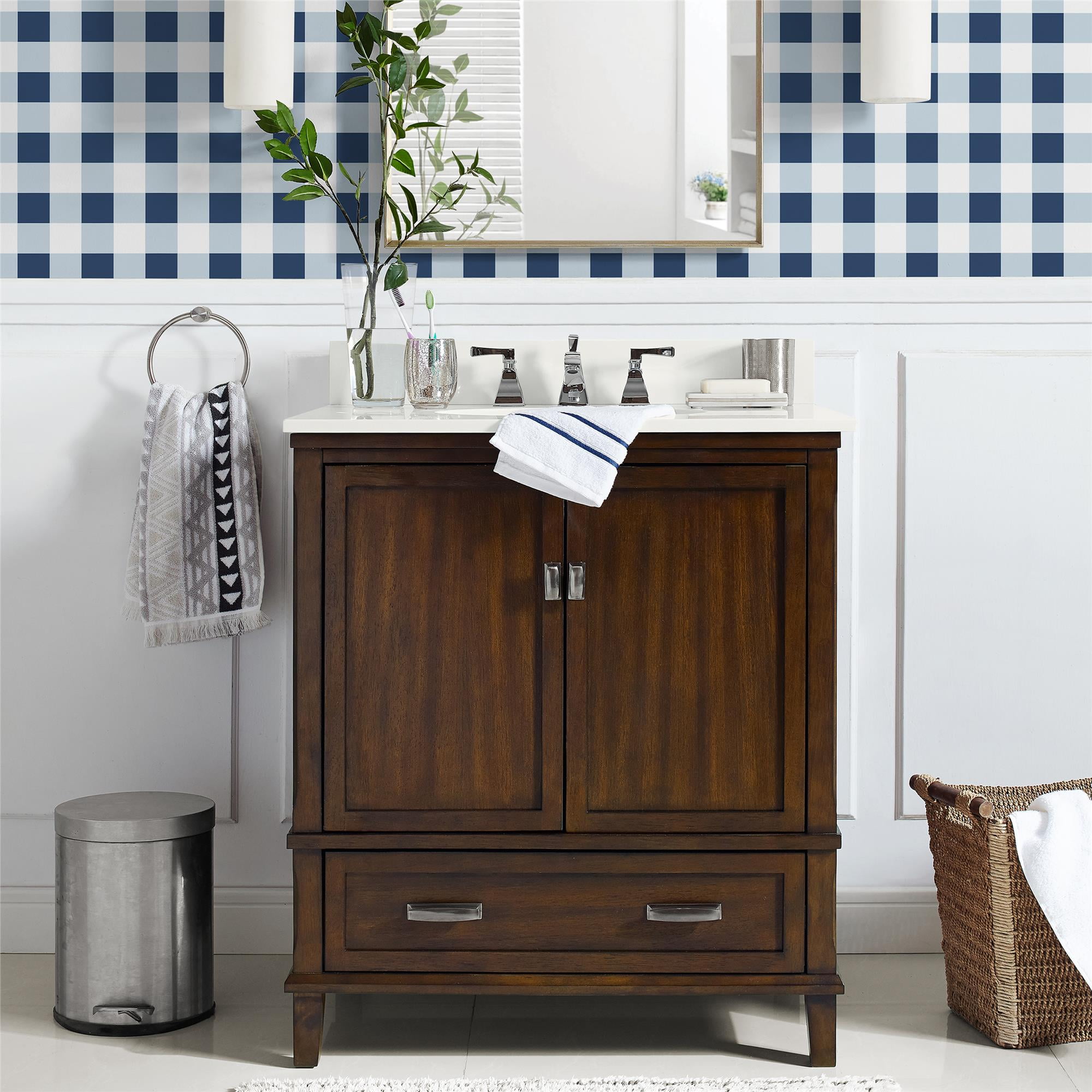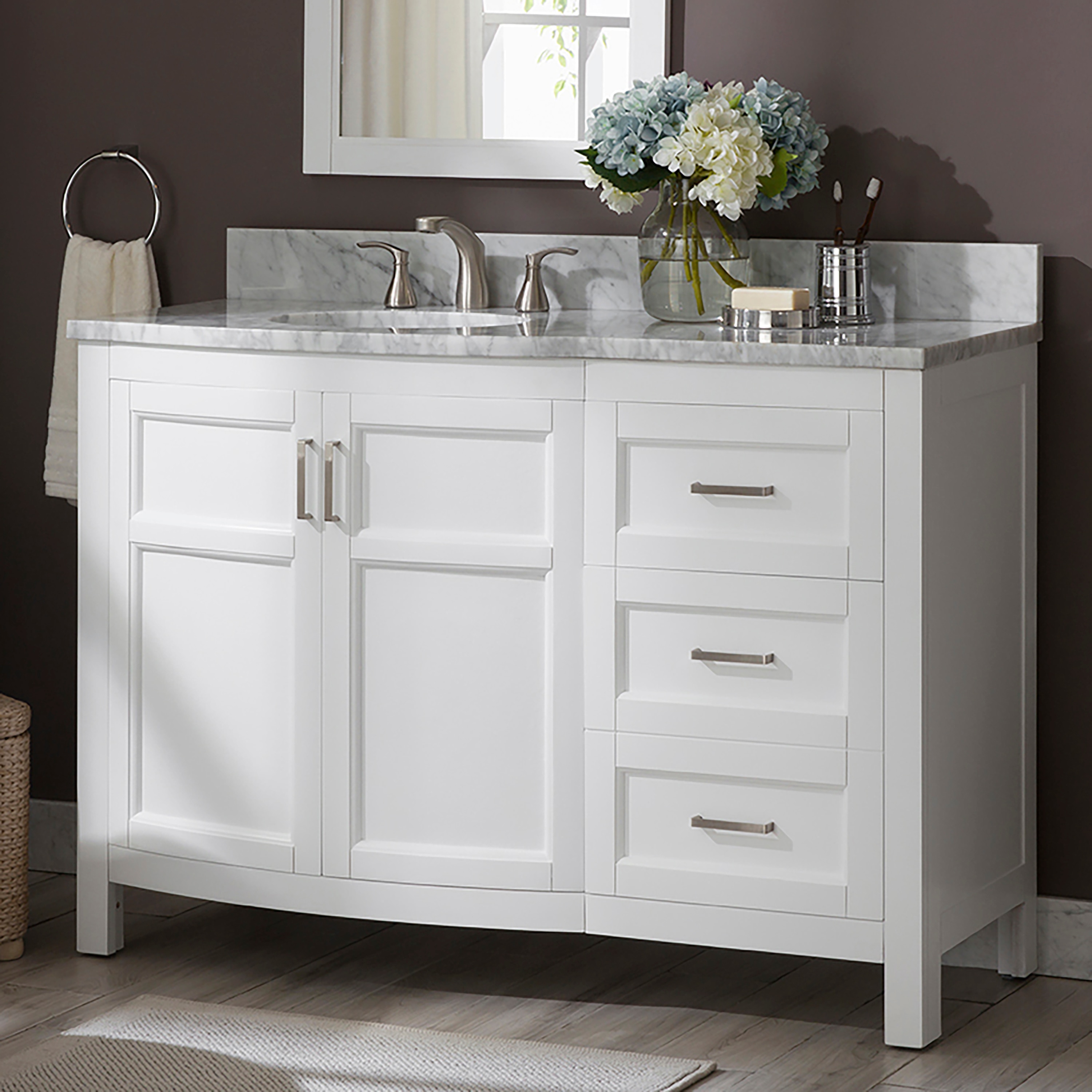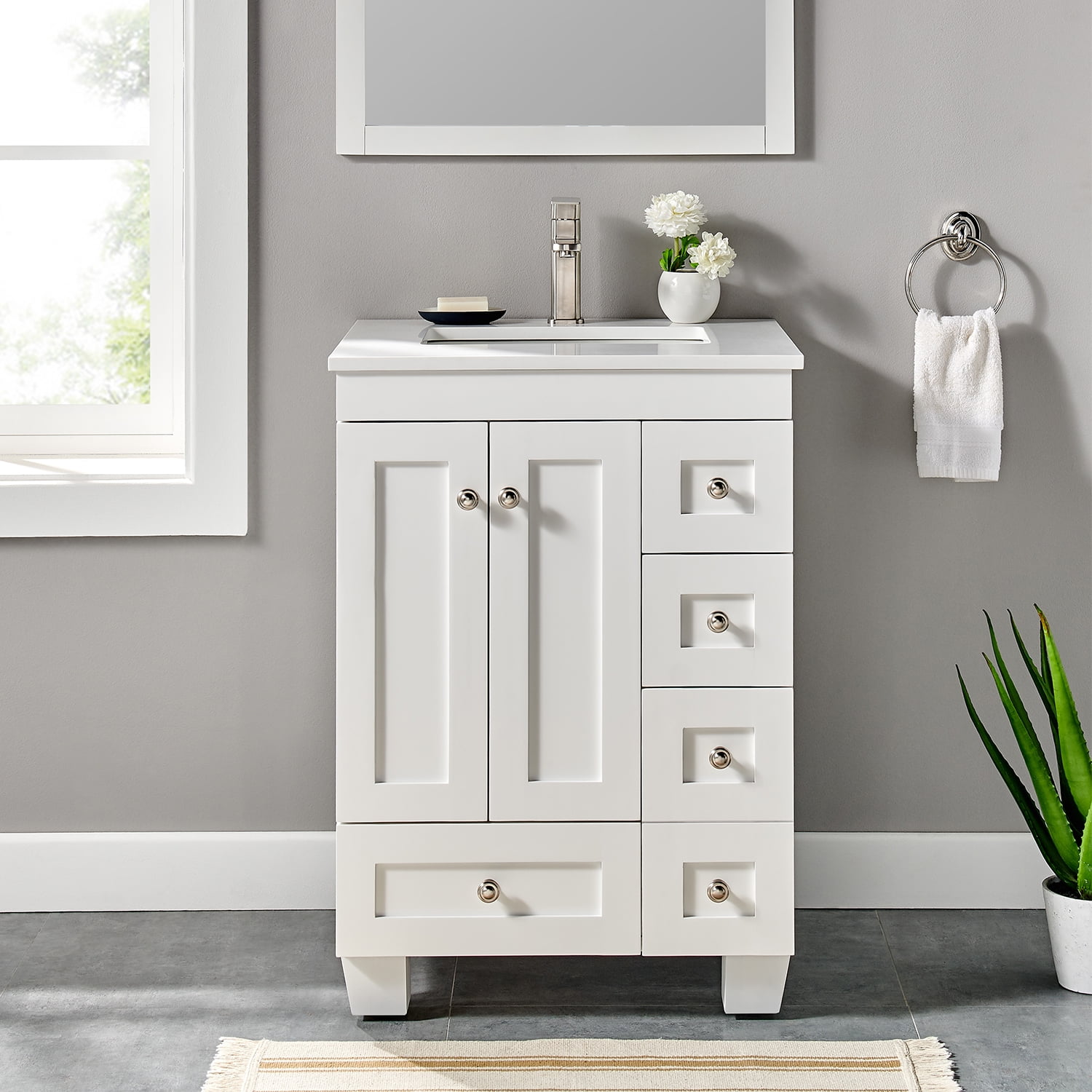Bathroom Vanity 31 Inches Wide: Design Considerations

A 31-inch wide bathroom vanity offers a balance between functionality and space-saving design, making it a popular choice for smaller bathrooms. This size allows for sufficient counter space and storage while minimizing the footprint in the room.
Advantages and Disadvantages of a 31-Inch Wide Bathroom Vanity
A 31-inch wide bathroom vanity presents both advantages and disadvantages, which are crucial to consider when choosing the right vanity for your bathroom.
- Advantages:
- Space-Saving: A 31-inch wide vanity is ideal for smaller bathrooms, as it takes up less floor space compared to larger vanities.
- Functionality: Despite its compact size, a 31-inch vanity can still provide ample counter space and storage for everyday essentials.
- Variety of Styles: A wide range of styles and designs are available in 31-inch vanities, catering to different aesthetic preferences.
- Disadvantages:
- Limited Counter Space: A 31-inch vanity might not offer enough counter space for larger bathroom accessories or multiple users.
- Limited Storage: Compared to wider vanities, a 31-inch vanity may have less storage space for towels, toiletries, and other items.
- Potential for Crowding: In smaller bathrooms, a 31-inch vanity might feel crowded, especially if there is limited walking space around it.
Design Options for 31-Inch Vanities, Bathroom vanity 31 inches wide
Choosing the right design for a 31-inch vanity is crucial for maximizing its functionality and aesthetics. Here are some common design options:
- Single Sink: A single sink vanity is a popular choice for smaller bathrooms, as it maximizes space and provides a streamlined look. This design is suitable for individuals or couples who prefer a minimalist approach.
- Double Sink: A double sink vanity is ideal for larger families or couples who require ample counter space and sink area for simultaneous use. However, a double sink vanity might not be feasible for a 31-inch wide space, as it might require a narrower sink or compromise on counter space.
- Floating Design: A floating vanity creates a modern and airy feel by attaching the vanity to the wall, leaving the floor open. This design is particularly useful for small bathrooms, as it visually expands the space.
Materials for 31-Inch Vanities
The material of a bathroom vanity significantly impacts its durability, aesthetics, and price. Here are some common materials:
- Wood:
- Pros: Wood is a natural and durable material that offers a classic and elegant look. It can be stained or painted to match any decor.
- Cons: Wood can be more expensive than other materials and requires regular maintenance to prevent damage from moisture.
- Laminate:
- Pros: Laminate is a cost-effective and durable material that is resistant to moisture and scratches. It comes in various colors and patterns to match any style.
- Cons: Laminate can be less aesthetically pleasing than wood or stone and might not be as durable in the long run.
- Stone:
- Pros: Stone, such as granite or marble, offers a luxurious and elegant look. It is durable and resistant to moisture and scratches.
- Cons: Stone is the most expensive material and can be heavy, requiring professional installation. It is also susceptible to staining if not properly sealed.
Countertop Selection for a 31-Inch Vanity
The countertop plays a vital role in the overall design and functionality of a bathroom vanity. It should complement the vanity’s style and material while providing a durable and practical surface.
- Material: Countertop materials range from natural stone (granite, marble) to engineered stone (quartz), laminate, and solid surface. Each material offers unique characteristics in terms of durability, aesthetics, and cost.
- Style: The countertop style should complement the vanity’s design. For example, a modern vanity might pair well with a sleek quartz countertop, while a traditional vanity could benefit from a classic marble countertop.
- Functionality: The countertop should be durable and resistant to scratches, stains, and heat. It should also be easy to clean and maintain.
Bathroom Vanity Layout for a Small Bathroom
Designing a bathroom vanity layout for a small bathroom using a 31-inch wide vanity requires careful planning to maximize space and functionality.
- Placement: The vanity should be placed against a wall to maximize floor space. Consider the location of the door, window, and other fixtures to ensure adequate walking space.
- Storage: Utilize the available storage space efficiently. Consider using drawers, shelves, and cabinets to organize toiletries, towels, and other items.
- Mirrors: Mirrors can visually expand the space and reflect light. A large mirror above the vanity can create a sense of openness.
- Lighting: Adequate lighting is essential for a functional and visually appealing bathroom. Consider using overhead lighting and vanity lights to illuminate the space properly.
Choosing the Right Bathroom Vanity 31 Inches Wide

A 31-inch wide bathroom vanity is a popular choice for smaller bathrooms, offering a balance of functionality and space-saving design. When selecting a vanity, consider several key factors to ensure it meets your needs and complements your bathroom’s aesthetic.
Storage Space
Storage space is a critical consideration, especially in smaller bathrooms. A 31-inch vanity may offer limited storage compared to larger models. Evaluate your storage requirements and choose a vanity with drawers, cabinets, or open shelves to accommodate your toiletries, towels, and other essentials. Consider the depth of the drawers and cabinets to ensure they can hold larger items.
Functionality
Functionality encompasses aspects like sink type, countertop material, and hardware. A 31-inch vanity can accommodate various sink styles, such as vessel sinks, undermount sinks, or drop-in sinks. The choice depends on your preferences and the overall bathroom design. Countertop materials, such as granite, quartz, or laminate, offer different durability, maintenance requirements, and aesthetics. Hardware, including knobs, pulls, and faucets, adds to the vanity’s functionality and style.
Style
The style of the vanity should complement the overall bathroom design. Consider the existing color scheme, materials, and architectural features. A traditional bathroom might benefit from a vanity with ornate details and a classic finish, while a modern bathroom could feature a sleek, minimalist design with clean lines.
Matching Vanity Style with Bathroom Design
Matching the vanity style with the overall bathroom design is crucial for creating a cohesive and aesthetically pleasing space. For instance, a farmhouse-style bathroom might benefit from a vanity with a distressed wood finish and rustic hardware. A contemporary bathroom, on the other hand, might call for a vanity with a sleek, modern design and minimalist hardware.
Vanity Brands and Key Features
Here’s a table comparing different 31-inch wide vanity brands and their key features:
| Brand | Style | Material | Features |
|---|---|---|---|
| Brand A | Traditional | Wood | Double sink, drawers, cabinets |
| Brand B | Modern | Acrylic | Single sink, drawers, open shelves |
| Brand C | Transitional | Laminate | Single sink, drawers, cabinet |
Choosing the Right Countertop and Sink
The countertop and sink are essential elements of a bathroom vanity. Consider the countertop material, sink style, and overall design harmony.
Countertop Material: Granite, quartz, and laminate are popular choices. Granite offers durability and natural beauty, while quartz provides stain and scratch resistance. Laminate is a budget-friendly option with various styles.
Sink Style: Vessel sinks offer a contemporary look, while undermount sinks provide a seamless and modern aesthetic. Drop-in sinks are a traditional choice with easy installation.
Measuring the Bathroom Space for Vanity Installation
Accurately measuring the bathroom space is crucial for ensuring a proper fit and avoiding installation issues. Here’s a step-by-step guide:
1. Measure the available wall space: Measure the width and height of the wall space where you plan to install the vanity. Allow for adequate clearance on either side of the vanity for movement.
2. Consider plumbing access: Ensure the vanity location has access to plumbing lines for the sink and faucet.
3. Measure the existing plumbing: If you’re replacing an existing vanity, measure the distance between the existing plumbing lines. This will help you choose a vanity with compatible plumbing connections.
4. Measure the vanity dimensions: Carefully measure the width, depth, and height of the chosen vanity. Ensure it fits comfortably within the available space, allowing for clearance for doors and drawers.
5. Factor in countertop overhang: If the vanity includes a countertop, consider the countertop overhang beyond the vanity base. Ensure the overhang does not interfere with doors or other fixtures.
Bathroom Vanity 31 Inches Wide

Installing a 31-inch wide bathroom vanity is a straightforward process, but it requires careful planning and execution to ensure a secure and functional setup. Proper installation involves understanding the necessary tools, materials, and procedures, as well as considering plumbing and electrical connections.
Installation Process
Installing a 31-inch wide bathroom vanity typically involves the following steps:
- Prepare the area: Clear the space around the existing vanity or the intended location. Remove any fixtures, mirrors, or accessories that may be in the way.
- Disconnect plumbing and electrical: Turn off the water supply to the vanity and disconnect the drain pipe. If the vanity has an electrical outlet, turn off the circuit breaker and disconnect the wiring.
- Remove the old vanity: If you are replacing an existing vanity, carefully remove it. Unscrew the vanity from the wall and disconnect the plumbing and electrical connections.
- Install the new vanity: Position the new vanity in its desired location. Make sure the vanity is level and secure. Use a level to ensure that the vanity is level in both directions.
- Connect the plumbing: Connect the drain pipe to the new vanity and tighten the connections securely. Connect the water supply lines to the new vanity and turn the water supply back on. Check for any leaks.
- Connect the electrical: If the vanity has an electrical outlet, connect the wiring to the outlet and turn the circuit breaker back on.
- Install the sink and faucet: Install the sink and faucet according to the manufacturer’s instructions.
- Install the countertop: If the vanity has a countertop, install it according to the manufacturer’s instructions.
- Clean up: Clean up any debris or spills.
Tools and Materials
The tools and materials required for installing a 31-inch wide bathroom vanity may vary depending on the specific vanity and the existing conditions. However, some common tools and materials include:
- Screwdriver
- Wrench
- Level
- Measuring tape
- Plumb bob
- Safety glasses
- Gloves
- Caulk
- Silicone sealant
- Screws
- Washers
- Nuts
- Plumbing tape
- Drain pipe
- Water supply lines
- Electrical wire
Plumbing and Electrical Connections
Proper plumbing and electrical connections are crucial for the safety and functionality of the bathroom vanity. Here are some important considerations:
- Plumbing: Ensure that the drain pipe is securely connected to the vanity and the main drain line. Use plumbing tape on the threads to prevent leaks. The water supply lines should be connected to the vanity and the shut-off valves. Make sure the connections are tight and leak-free.
- Electrical: If the vanity has an electrical outlet, ensure that the wiring is properly connected and grounded. The outlet should be installed in a location that is safe and accessible.
Sealing and Protection
Sealing and protecting the vanity from water damage is essential for its longevity.
“Water damage is a common problem in bathrooms, so it’s important to take steps to prevent it.”
Here are some tips for sealing and protecting the vanity:
- Caulking: Apply caulk around the sink and countertop to prevent water from seeping into the vanity.
- Silicone sealant: Use silicone sealant to seal any gaps or cracks in the vanity.
- Water-resistant finishes: Choose a vanity with a water-resistant finish, such as a laminate or solid surface countertop.
- Ventilation: Ensure that the bathroom has adequate ventilation to prevent moisture buildup.
Maintenance and Cleaning
Regular maintenance and cleaning are essential for keeping the vanity looking its best and extending its lifespan.
“A well-maintained vanity will last for years to come.”
Here is a checklist for regular maintenance and cleaning:
- Clean the countertop and sink: Wipe down the countertop and sink with a mild cleaner and a soft cloth.
- Clean the cabinet doors and drawers: Wipe down the cabinet doors and drawers with a damp cloth.
- Clean the hardware: Wipe down the hardware with a soft cloth.
- Check for leaks: Check for any leaks around the sink, faucet, or drain pipe.
- Inspect the caulk and sealant: Inspect the caulk and sealant around the sink and countertop for any cracks or gaps.
